The sailplanes
|
|
Green Jouster
|
Red Jouster
|
Tropic Bird
|
Super Sportster 20
|
Zagi 400E
|
|
Span:
|
78"
|
78"
|
78"
|
48"
|
48"
|
|
|
Weight:
|
+49 oz
|
48 oz
|
25 oz
|
3lb+13oz
|
22oz w/8cell
|
|
Wing loading:
|
+9.5 oz/ft
|
9.3
|
5.8 oz/ft
|
???
|
???
|
|
Airfoil
|
SD7032
|
SD7032
|
SD3021
|
fully-symmetric
|
ummm...
|
|
First Flight
|
19 June 1995
|
June 1997
|
August 1999
|
9 July 1992/31July2000
|
19 July 2000
|
The Jouster Original page Aerial photography!

The Tropic Bird -- Designed by Wayne Westphal. Built 1999 by Tim Czerwonka.
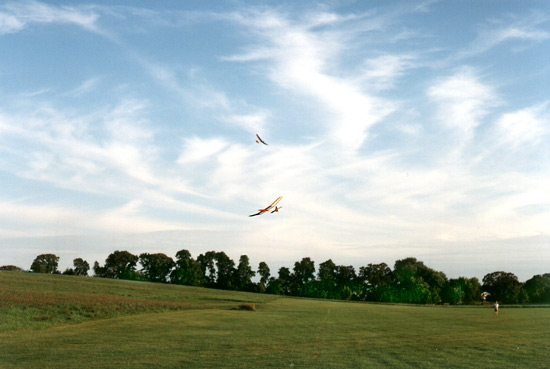
Above, my Tropic Bird (lower) circling to land. Madison, Wisconsin, 1999
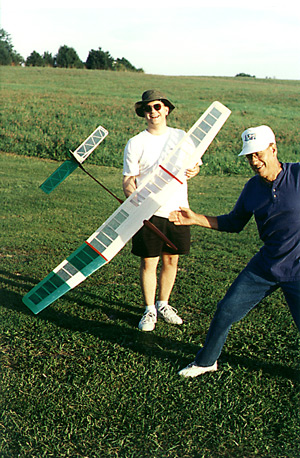
|
|
Tim with the Tropic Bird (holding plane) and Wayne Westphal (jumping in picture), designer of the aircraft.
|
The Tropic Bird is a scratch-built sailplane designed by Madison local
sailplane flier Wayne Westphal. Here's how I came to build one.
If you've read the pages, you know I've got the Jouster sailplanes.
They fly well enough, but they're heavy and really designed for hauling
up on a winch and flying in significant wind -- the Jouster did excellent
in high wind. I would fly it at the sailplane field in Madison and get
a three, maybe four minute flight. Of course, for that three minutes,
I had undoubtedly the fastest sailplane at the field. I still think
the plane would be a blast if it had a 40 bolted to the nose.
One Wednesday (regular club flying night) I went out to the field with
no plane. Of course, Wayne, who has planes you'd have to be daft not
to admire, asked me where mine was. I'm sure I had some lame excuse.
In the meantime, Wayne had managd an effortless and high launch with his
Tropic Bird on this dead-calm evening. He then handed me his controls
and walked off. Aaaaa! After the shock subsided, I proceeded to steer
this plane around the sky for five minutes. I was close enough to the
ground and decided to let Wayne finish with a few more laps around the
field and conclude with a smooth landing.
I was sold. I had to build one.
That evening, I followed Wayne back to his residence and picked up
a set of plans and a carbon fiber tailboom for the plane. The last
set of plans Wayne had at the moment were the "spare" set taped to his
other bench. Was it OK that he had made some notes and changes on there?
Hey -- some people would pay extra for that alone! While I was there,
I had the opportunity to see some of Waynes other aircraft -- CL planes
of his own design, several versions of the Trumpeter (another one of
his designs) and the new Tropic Bird with the fiberglass fuselage. One
thing all of these planes had in common -- impeccable construction and
perfect covering and finishes. Well, I saw what I had to do. I think
I started tracing and cutting templatest to cut the ribs that night.
Fourteen months passed. I finally finished the plane. Does the Tropic
Bird take fourteen months to build? It does if you don't work on it
for at least twelve of 'em, live in a small apartment and get constantly
interrupted by this thing called "work". Well, at least the interruption
keeps me off the streets, pays the bills and finances carbon fiber for
sailplane wings. I can't complain.
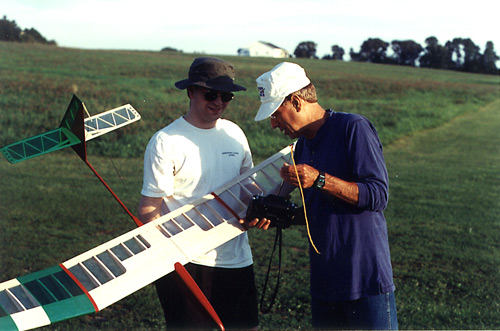
|
|
This is Wayne noticing I had a tiny little wrinkle in my covering job. I should have known that he'd notice.
|
I finished the plane in August of 1999. Took it to the flying field one
evening to test. As I had hoped, Wayne was at the field to give it some
sort of nod of approval.
What can I say? It flew. Then again, I had no suspicions that it wouldn't.
It flies pretty well. I don't remember any times from that evening, but a
seven minute flight on a calm night -- no rising air -- isn't hard to get
when provided with a good launch.
Details
So, what about plane details? The Tropic Bird is a 2M sailplane designed
with a 1/64 ply sheeted lite-ply fuselate boom connected to a 3/8" carbon
fiber tailboom. The tail sports a full-flying stabilator, fin and rudder.
The wing is a sigle piece with provisions for spoilers -- which I allowed
for in building, but did not opt to install. Spar is spruce laminted with
carbon fiber, top and bottom, full shear webs and leading edge D-tube.
A single center-section and cap strips round out the wing features. I
can't say I felt it necessary to deviate from anything in the plans. Ok,
I did make the rudder of mine a bit different -- with diagonal bracing --
but not like that's a major design issue.
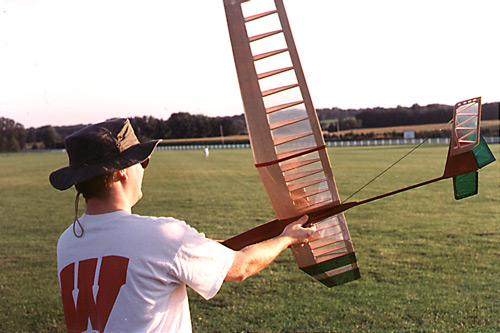
|
|
View of the aircraft fuselage, covering scheme and some dork with a big "W" on his back. Oh, I guess that's me. Nevermind.
|
Contest!
I placed in my first contest with the Tropic Bird. I placed second in
RES-class (Rudder-Elevator-Spoiler control only) in the 1999 Madison
Fall Thermal Soar -- third overall, point-wise. The day was bleak, cold,
windy and I flew my last round looking up in the rain. Damn frontal passage.
There were two other Tropic Birds at the event, one belonging to Wayne
Westphal and another belonging to Bill Maloney (I think). For the 2,
3 and 4 minute precision tasks, the order of business after launch was
basically hold down elevator and make the plane come down. I found out
that the plane can be winched up pretty hard, and if you winch it really
hard for the 2 minute, you'll need that long just to get it down.
Second and 3rd round was 10-minute precision. Ok, how the hell do you get
ten minutes when the air isn't going up? Nevermind that I had a flight of
9:58, I can't say for sure why the plane stayed up. My first thought was
just to head out upwind after launch. I was way the hell over a cornfield
and think I must have had ridge lift off that. Either that or the plane got
launched above some boundary layer. I don't know. But, it was a two minute
flight back to hit the field, downwind. It was OUT THERE. I didn't do so
hot in the second 10-minute precision round -- then again, it was mostly luck
for my first round. The last round (decathalon?) was spent flying,
looking up as the rain came down.
In any case, I was VERY surprised to find out that I came in second. First
place went to Larry Landucci, flying a huge Sailaire.
What's next?
What's next? I want to build a new wing for the plane. This one will get
ailerons. I think I can increase performance if I add ailerons to coordinate
the turns. As long as I'm at it, I'm thinking about flaps too.
Flaps? Not just a flap, but a Fowler flap. Yeah, the kind that extend
AND drop. Will it add weight? Probably. Performance? I don't know.
Will it be nifty? You bet. Will I learn anything? If I didn't
think so, I wouldn't bother. See my preliminary rough drawing.
I'm thinking that my tracks might even be field interchangeable -- one set
for more extension / less drop, another set for more drop / less extension.
A third set to fulfill the wish of, "gee wouldn't it be nice if..."
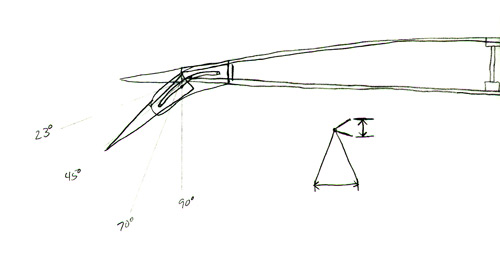
Aerial Photography
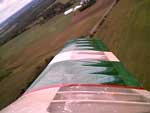 What, you mean with this plane? Sure. Check out this page for more info.
What, you mean with this plane? Sure. Check out this page for more info.
All photographs on this page were taken by Carrie. Pretty good, eh?
This page last modified:
Tue Oct 5 00:52:44 CDT 1999
by
timc!






